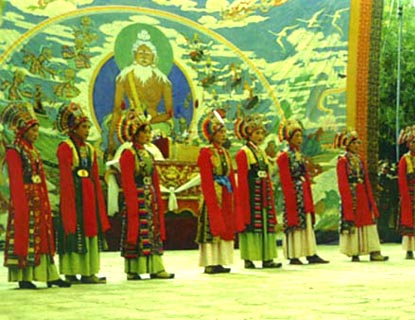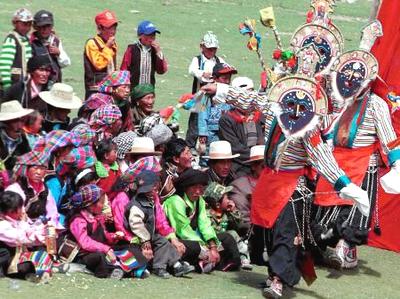|
Tibetan Opera, or Ace Lhamo in Tibetan, is an ancient art form that has developed over the centuries. Hailed as "the living fossil of traditional Tibetan culture," it boasts a history of more than 600 years -- about 400 years longer than China's national treasure, Peking Opera.

Tibetans have long cherished this important folk art, which has become a source of identity for them. It is said that wherever you find Tibetans, you will find Tibetan Opera.
 Tibetan people's "fairy sisters" Tibetan people's "fairy sisters"
There is a beautiful legend about Tibetan Opera in its present form. During the 14th century, a high-ranking monk and bridge builder named Drupthok Thangthong Gyalpo decided to build iron bridges across all of the major rivers in Tibet to improve transportation and facilitate pilgrimages.
To fund the project, Thangthong Gyalpo created a singing and dancing group of seven beauties to dance while he played the cymbals and drums. They performed throughout Tibet to earn money for his bridge project. This is believed to be the source of the present Tibetan Opera.
Tibetan Opera became known in the local language as Ace Lhamo ("fairy sisters"), and Thangthong Gyalpo himself is considered as the father of Tibetan Opera.
To honor the great founding father, a blessing of his statue always precedes each Lhamo and usually ends with the presentation of the hada (a strip of raw silk or linen used for ritual greetings) by the performers and audience members.

 From ritual dances to cultural syncretism From ritual dances to cultural syncretism
However, some say the origin of Tibetan Opera goes back a millennium to Tibetan ritual dances and early Indian Buddhist drama. Since Buddhist teachings and Tibetan history have provided the inspiration for Tibetan Opera, most of its repertoire is based on Buddhist stories and Tibetan history.
According to Tibetan historical records, when Princess Wencheng of the Tang Dynasty (618-907) was married to the Tibetan King Songtsan Gambo, she brought the costumes, music, and dances of the Han people to Tibet. Such items were greatly admired by the king, who in turn, had 16 beautiful girls trained in an art form combining the Han-style and Tibetan folk music and dance to entertain the princess.
|
